Special Hobby 1/32 Westland Whirlwind I
The Airplane:
The Westland Whirlwind was, at the time of its initial appearance, one of the most advanced fighter aircraft ever built. Unfortunately, it was built to an official specification that was inherently limited, most definitely by the choice of the thoroughly second-rate Rolls-Royce Peregrine engine for its powerplant; the problems of the Peregrine had a great deal to do with why the Whirlwind was not available in numbers for the battle it was designed for - the Battle of Britain - and there was no likelihood of Rolls-Royce being able to devote the engineering time and talent necessary to make it right in the light of the demand for the far superior Merlin. By the time the idea of powering the Whirlwind with the Merlin was brought up, the design of the aircraft had been superseded. Thus, the aircraft was never able to live up to the hope expressed in its initial design.
That said, within its restrictions of size and powerplant, the Whirlwind was a very good fighter. Below 10,000 feet, a competent pilot could take on the German Bf-109 with confidence, and with the then-stunning centerline armament of four 20mm cannon, there was very little in the way of potential targets that could survive a burst of fire.
The Whirlwind came into existence as a result of Air Ministry Specification F.37/35, issued in 1935, a time when the standard RAF fighter carried two rifle-caliber machine guns and was nothing more than incrementally improved over what had flown on the Western Front 20 years earlier. The airplane that resulted from the specification was revolutionary: the first single-seat, twin engine, cannon-armed fighter to be produced and used operationally by any air force.
Design work began in 1936 under the leadership of the legendary W.E.W. Petter - who would go on to design the Canberra - and the Westland design beat submissions by both Bristol and Hawkers, with an order for two prototypes placed in February 1937. The first prototype, L6844, was flown by Westland chief test pilot Harald Penrose at Yeovil on October 11, 1938, and it rapidly proved itself faster at low altitude than any other fighter then in existence.
The twin-engine configuration was chosen because there was not an engine of sufficient power on its own to provide the necessary speed while carrying the never-before-heard-of armament of 4 20mm cannon; additionally, the layout allowed this heavy armament to be placed directly on the centerline, providing a concentration of firepower of 600 lbs/min, which would not be equalled by another fighter until the appearance of the Bristol Beaufighter. The pilot was provided with the first "bubble canopy" to be used by any combat aircraft, conferring excellent view in all directions.
From the flying viewpoint, the Whirlwind had excellent maneuverability and an outstanding rate of climb that suited it perfectly as a point-defense fighter in opposition to bombers. While Handley-Page slats were fitted to the outer wings, the production aircraft flew with them locked shut, since at least one crash of the test aircraft was attributable to slat failure.
After being handed over to the Royal Aircraft Establishment at Farnborough, the Whirlwind demonstrated such performance that an order for 200 was placed in January 1939, with first delivery for the following September.
In May, 1939, the still-secret fighter was demonstrated to several Members of Parliament at Northolt. In the words of one M.P., "the fastest time of the day was not put up by the Spitfire, but by a secret twin-engined machine that streaked over from the west." In fact, below 5,000 feet, the Whirlwind was 15 mph faster than the Spitfire I.
Unfortunately, Whirlwind production fell badly behind schedule, with the main culprit being the non-delivery of Peregrine engines by Rolls-Royce, due to the need on their part to increase production of the Merlin. Rather than September, 1939, the first production Whirlwind - P6966 - did not appear until May, 1940. Initially, the airplane was to equip 25 Squadron, which was then flying Blenheim IFs. Due to a change in re-equipment policy, the first Whirlwind squadron was 263, which had flown Gloster Gladiators in Norway that Spring, with the first Whirlwinds arriving on July 6, 1940.
As a picture of things to come, the first write-off of a Whirlwind with 263 Squadron ended in disaster on August 7, when Pilot Officer McDermott took off in P6966, the first production aircraft. The right main wheel burst its tire right at takeoff, though McDermott was able to get airborne. He then learned the landing gear was badly damaged; he could not land on it and could not retract it for a wheels-up landing. After baling out, the Whirlwind went 30 feet deep when it struck ground; to top things off, McDermott was mistaken as a German by the local Home Guard and made prisoner.
Due to lack of engines, 263 only had eight Whirlwinds as of October 1, 1940. 263 finally became operational on December 7, 1940, and had flown 30 sorties by the end of the month. Their first combat came on January 12, 1941, when P/O Stein and Flt. Sgt. Mason were ordered to intercept a Ju-88 returning from a raid. Stein intercepted the German bomber 40 miles southwest of the Scilly Isles and hit the Ju-88 solidly, though he could not observe a crash in the cloudy weather and was only credited with a "damaged." On February 9th, F/O Hughes and P/O Graham destroyed an Arado Ar-196 south of Dodman Point. During the first four months of 1941, 263 lost six pilots through flying accidents and three in action.
In June, the squadron began Warhead operations, which were strafing sorties against German targets in northwest France and the Low Countries, and by that August had destroyed three Ju-88s, eight Ju-87s and five Bf-109s on strafing missions, as well as sunk one E-boat. On August 7, 1941, four Whirlwinds were intercepted by 20 Bf-109s; the Whirlwinds managed to shoot down two of their attackers, in a fight in which two of the four were damaged and a third force-landed when it returned to base. 263 had demonstrated the value of the Whirlwind in low altitude operations, and that it could defend itself when necessary.
A second order for 200 Whirlwinds that had been place in October 1939 was cancelled, while the original order for 200 was reduced to 114, the last of which left the production line in January 1942.
In September, 1941, the Whirlwind equipped a second unit when 137 Squadron took three on charge. On February 12, 1942, during "The Channel Dash," 137 lost four Whirlwinds in a dog fight with 20 Bf-109s defending the German warships.
While 263 Squadron found their hunting grounds around the Brest and Cherbourg on the Cotentin Peninsula, 137 - operating from Manston - covered the Channel and Northern France. Both units became well-known for train-busting, with one pilot from 137 taking out four locomotives on one mission. Both squadrons developed night attack capability, destroying nearly half the trains they were credited with during night strafing missions.
On July 21, 1942 263 Squadron first attempted to turn the Whirlwind into a fighter-bomber, equipping one aircraft with racks for a 250-lb or 500-lb bomb outboard of each engine. The first test mission of the "Whirlibomber" took place on September 9, 1942, when eight Whirlwinds attacked four armed trawlers near Cherbourg, sinking two of them.
The Whirlwinds were finally taken off operations in the Spring of 1943, when first 137 and then 263 Squadron were re-equipped with Typhoons.
The Kit
Modelers have long liked the Whirlwind. The airplane exudes power and performance in its out-of-the-ordinary design.
Previously, the Whirlwind was first released as a 1/72 kit by Airfix in the early 1960s; I remember buiilding several of them. The kit was first released in 1/48 as a multi-media vacuform by Cooper Details with an excellent resin cockpit; I built one, still have it, and it looks good - the kit would still be a good choice if you ran across one. In around 2002-03, Classic Airframes released a limited-run injection-molded kit, which used the Cooper Details resin cockpit and vacuform canopy; this was later re-released with a plastic canopy, and is considered one of CA's better kits. Trumpeter released a mainstream injection-molded kit a few years ago which is not one of their better efforts.
Special Hobby announced they were doing the Whirlwind in 1/32 two years ago. The kit was delayed by The Past Godawful Year, and has now been released.
This is without a doubt the best kit of the Whirlwind released by anyone to date. The kit has beautiful surface detail with both raised and engraved rivets and panels, all done in a very petite manner. The cockpit is fully detailed and caters to both early and late production details. Bombs and racks are provided for a “whirlibomber,” though none of the four markings options would cover that role. The markings include four options, all from 263 Squadron - two in Dark Earth/Dark Green/Sky, and two in Mixed Grey/Dark Green/Sea Grey Medium; all come from the 1941-early 1942 period by the insignia. The two-piece canopy has a windscreen molded integral with the surrounding fuselage, which will guarantee no gaps. The kit does not include any photoetch and a modeler will have to source seatbelts in aftermarket.
Special Hobby will obviously release other options - airplanes from 137 Squadron, Whirlibombers, etc., as they always do to maximize the life of the molds.
Construction:
The good news is, this isn't a difficult kit. The bad news (which isn't very) is that you have to remember that it's a high-end/limited-run kit. Pay attention to the latter and you can achieve the former.
The radiator detail in the wings will not be seen once assembled, even if you open up the waste gates in the wings. The internal structure does give the wing some rigidity it wouldn't have otherwise.
Most of the cockpit can be seen, so that's good. The detail is all injection plastic and looks good when finished. You need to pay close attention to the instructions to figure out where everything goes.
All the seams needed filling. I got the fit as tight as possible, then used CA glue over the seams to make them disappear for certain. I used my pounce wheel to rescribe the very petite surface detail.
Afteer getting most of the model assembled, I discovered the bomb racks. One can be excused for thinking the bomb racks on the sprues are parts for the complex landing gear assembly, but a second look and the project became a Whirlibomber.
The hardest part was bending the engine nacelles so the forward bulkhead would fit right, since it has the mounts for the main gear.
Painting:
The airplanes were all delivered in Dark Earth/Dark Green/Sky. In August 1941, the Dark Earth got overpainted most likely with "mixed grey" given the shortage of the new Ocean Grey color paint, while the Sky got overpainted with Sea Grey Medium. The instructions for "mixed grey" were 50/50 Night and White, which is the same mixture for Neutral Grey, so I used Tamiya XF-53 "Neutral Grey". I also used XF-81 "RAF Dark Green" and XF-83 "Sea Grey Medium." Fortunately these could be done freehand, since the airplanes were repainted "in the field."
I painted it in the "Operation Starkey" scheme. Interestingly enough, most modelers (including yours truly on a previous Whirlwind project) fail to get these markings right. There are a few photos (included here) of the airplanes during the operation which show the markings.
First, I preshaded with black along the panel lines. Then I shot the white; since this was temporary and these markings were only on for a few days, I did this "rough" so that there is an "intimation of another color beneath." I then masked those off - the wing stripes are 18 inches wide (9/16 in 1/32). The "Duck Egg Blue" was then applied, and the rear fuselage stripe masked off - I left the lower ends of the tape loose so that when I painted the lower surface I could overpaint the stripe, as I noticed it was in one of the photos. Then I shot the flat black, also going for a "rough" appearance like the white.
By this time (Septembr 1943), the airplanes were getting a bit "long in the tooth." 263 was the only squadron still equipped with them. This information is necessary in choosing how to paint the model.
There is a slight degree of difference in grey tone between the rear fuselage stripe and the squadron codes. I took this to be that the stripe and spinners had been painted back in 1940/41 in "Duck Egg Blue," which was not overpainted afterwards. To get this, I used Tamiya XF-21 "Sky" (lightened with white to get the proper Sky shade - out of the bottle the color is too dark) mixed 4 partsSky to 1 part XF-23 "Light Blue" (which is actually RLM 65 Blue, a nice turquoise color).
For the overall camouflage scheme, I started with the Sea Grey Medium, going back over it with a bit of white added in the cup. Then the Neutral Grey, also gone over with a lightened shade. The Dark Green was given the most "weathering" of all since it would have been the color on the airframe the longest (back in the factory)
I found a photo of a Whirlibomber being loaded with "old" 250-lb bombs with the warhead painted the prewar pale yellow and the tails being new and painted green. I thought it looked good so I appropriated it here.
Decals:
I modified kit decals to do HE-L/P7085. I used Tamiya decals from a 1/32 Spitfire kit for the C.1 roundel and the fin flash.
Final Assemblhy:
I attached the main gear, then unmasked the canopy and attached it in the open position. I finished by attaching the props.
Conclusions:
Overall a nice kit. I think the MSRP of $117 is a bit high, but I see it at online shops for around $85-$90.
If you like the Whirlwind, this is the best kit of the airplane in any scale. Size wise, the "footprint" of the model is about 2/3 that of a 1/48 B-17.


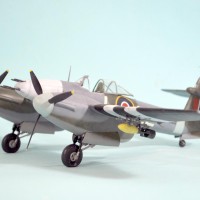
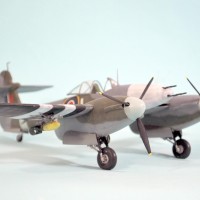

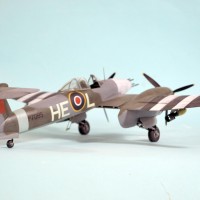












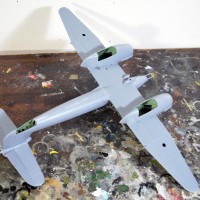



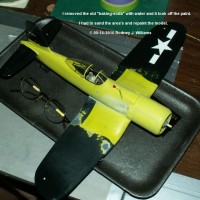



This is yet another of your superb builds, Tom: an excellent result!
Thanks for the kit info: we do live in the golden age of modeling!
Amazing as usual, Tom @tcinla
Great build and paintwork.
Thanks for sharing the historical background and kit information.
Nice build and the finish. Great looking Whirlwind.
Good looking model, Tom and I appreciate the back story to the plane!
Great looking build Tom!
Also, I found the detailed history you provided quite interesting.
Nicely done Tom, enjoyed the history lesson as I had no idea the Whirlwind actually saw combat. Never see them in BOB or other combat films.
Beautiful build of a great kit, Tom@tcinla. You did a fine job on the cockpit detail painting. The camo and ID stripes are expertly executed. I have this kit in my stash and plan to do a Canadian version within the RAF. I may get a second kit to do the alternative earth and green scheme as well, which is very attractive. I don't know if this camo was used on any in-service aircraft or only on test versions. BTW, I did the CA multimedia kit some years ago and was horrified to find that the vax canopy had gone completely yellow with time. Don't know if I will ever have the energy to replace it.
Your capsule history of the Whirlwind is fascinating as usual. One thing that has always intrigued me is the number of Canadian pilots who flew the Whirlwind. One example is J.P. Coyne, HE-T P7094, of 263 squadron (see links below). The RCAF pilots of 25, 163 and 137 squadrons really liked the Whirlwind and got the most out of it, in spite of the troubled engines.
https://www.iwm.org.uk/collections/item/object/205448300
https://www.silverhawkauthor.com/post/canadian-warplanes-3-westland-whirlwind
Great to see this in headlines. Thanks for posting.
Another splendid rendition sir
Once again, a great Whirlwind history lesson and superb model, Tom @tcinla. I wish SH would downsize this kit and give it to us in 1:48 scale.
Great links Colin @coling - the silver hawk link is a real rabbit hole.
Very cool Tom @tcinla I like this a lot. I really hope they scale this down to 1/48!
I've asked about it in 1/48 - the answer was "no plans." They did the 1/32 Tempest II and didn't do the 1/48 Tempest II until Eduard did it and they did it with them.
Nice build! The old Airfix Whirlwind was one of my earliest builds when I returned to the hobby. I think I need another, and I really like these markings (and all the detail you provided about how to achieve the scheme). Great post!
Well done, Tom. You’re inspiring me to build the lousy Trumpeter kit in the stash.
@j-healy - Noooooo! Don't make a Whirlwind if all you have is that collection of scrap plastic.
It was the last kit I ordered sight unseen. Learned a lesson from that……….
@j-healy - Fortunately not really expensive, but enough to take notice.
Beautiful build, Tom, and I always enjoy the history you build around each one. I was inspired to tackle the Classic Airframes version of the Whirlwind from a previous article you wrote. Great to see your version of this one - it's a handsome model!
Another great one, Tom.
I remember the original Airfix kit from the 60s but I don’t think my feeble efforts did justice to the beautiful lines of the Whirlwind. You’ve done a fab job on this kit.
The model came out beautifully. It was always a mysterious construction for me and I used to call it a little mosquito when I was still in school 🙂
Beautiful build of a very cool subject. It looks like a racer. Also, it reminded me there's a 72 scale kit in the stash; can't recall the brand right now, but it has resin and PE parts. Imagine being in the receiving end of all that firepower...
Fantastic build! I really like the old Whirlwind.
I’m in the process of building this kit and I'll be happy if mine comes out half as nice as yours. I enjoyed your history of the plane. Here's a link to some more info about the Whirlwind including a link to a video of Whirlwinds flying. https://ww2aircraft.net/forum/threads/westland-whirlwind.47081/